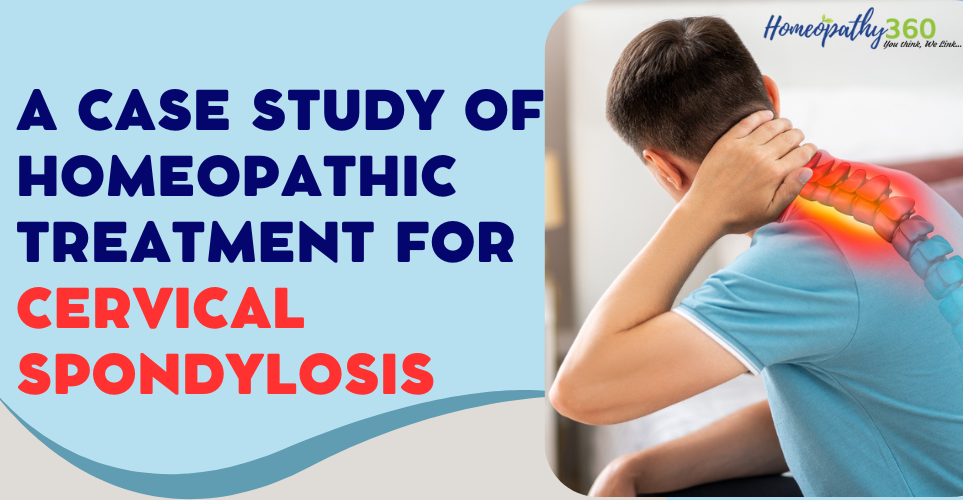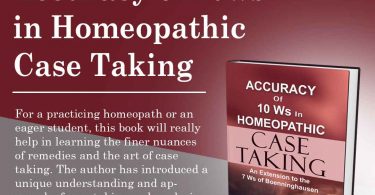
Abstract
Cervical spondylosis, a degenerative condition affecting the cervical spine, presents with various symptoms such as neck pain, stiffness, and reduced range of motion, often leading to discomfort and decreased quality of life, particularly among adults above 40. Contributing factors include age-related changes, repetitive neck movements, poor posture, and genetic predisposition. Lifestyle factors like smoking and obesity also elevate risks. Homoeopathy offers a holistic approach to managing cervical spondylosis, aiming to alleviate pain, reduce inflammation, and enhance overall well-being. A 49-year-old homemaker presented with recurrent neck pain, numbness in the right hand, and hypothyroidism. She received individualized treatment over five months. The patient exhibited variable responses, with notable improvements in lumbar pain and fluctuating relief in cervical pain. This case underscores the complexity of musculoskeletal complaints and the importance of tailored treatment in homeopathy.
Keywords:
Cervical spondylosis, homoeopathy, holistic approach
Introduction
Cervical spondylosis, also known as cervical osteoarthritis or neck arthritis, is a degenerative condition affecting the cervical spine. It typically develops due to the wear and tear of the bones and cartilage in the neck region over time. This condition is prevalent among adults, especially those above the age of 40, and can lead to significant discomfort and reduced quality of life.
Several factors contribute to the development of cervical spondylosis, including age-related changes in the spine, repetitive neck movements, poor posture, genetic predisposition, and injuries such as neck trauma or fractures. Lifestyle factors such as smoking and obesity may also increase the risk of developing cervical spondylosis.
Common signs and symptoms of cervical spondylosis include neck pain, stiffness, and decreased range of motion. Patients may also experience headaches, tingling, numbness, or weakness in the arms, hands, or fingers. In severe cases, cervical spondylosis can lead to complications such as cervical radiculopathy or myelopathy, which may cause more severe neurological symptoms.
Cervical spondylosis can lead to various complications, including nerve compression, spinal cord compression, and the development of bone spurs (osteophytes). These complications can result in chronic pain, muscle weakness, and functional impairments, affecting an individual’s daily activities and overall well-being.
Homoeopathy offers a holistic approach to the management of cervical spondylosis, focusing on individualized treatment based on the principles of similars and the body’s inherent ability to heal itself. These remedies aim to alleviate pain, reduce inflammation, improve mobility, and enhance overall health and vitality.
Case Profile
A 49-year-old homemaker, presents with a two-year history of cervical spondylosis characterized by recurrent neck pain, occasional radiation of pain and numbness to the right hand, and intermittent relief with warm water fomentation. Additionally, she has been diagnosed with frozen shoulder on the right side two months ago and on the left side six months ago, resulting in pain and restricted movement. Physiotherapy has been initiated to address the frozen shoulder. Alongside these musculoskeletal complaints, the patient reports dryness of the tongue and mouth, throat pain after prolonged talking, and a burning sensation in the right foot. She also has a history of hypothyroidism, for which she is currently on Thyronorm medication. In light of her symptoms, a holistic approach to treatment is warranted.
Past history
Hysterectomy-2017
Fibroids-heavy bleeding
Family history
Mother – HTN
Physical Generals
| Diet | Veg |
| Appetite | Normal |
| Desire | Spicy |
| Aversion | N.S |
| Thermal Reaction | Chilly, Cannot tolerate cold |
| Thirst | 3-4 liters per day |
| Stools | Normal |
| Urine | Normal |
| Perspiration | Scanty, NO , NS |
| Sleep | 5-6 hours restful |
| Dreams | N.S |
| Nails | Previously experienced discoloration or blemishes on nails, along with fissures. |
| Menstrual cycle | Heavy flow occurring every two weeks or every 10 days, lasting for 4-5 days. History of hysterectomy in 2017 due to fibroids. |
Mental Generals –
The patient is a homemaker living in a nuclear family setup with her husband and 20-year-old son, who resides in Chennai. Her son is described as quiet and reserved, preferring not to socialize much. The patient enjoys teaching children and has been working as a teacher, providing tuitions in subjects like mathematics and science. She has a calm demeanor and doesn’t easily get angry, although her husband’s irritable nature affects her mood, though she has become accustomed to it over time. She used to feel upset when her husband shouted, but now she doesn’t take it to heart as much. Previously, she worked in an Air Force school for 10 years and lived in Baroda for 5-6 years before settling in Thane for the past 17 years. Her focus is on maintaining cleanliness and tidiness, and she takes pride in doing her work diligently, particularly in teaching chemistry. While she values punctuality to some extent, she isn’t overly strict about it.
Case analysis
Repertorial totality
Generalities; Chilliness; General; Sensation; Chilliness
Mind; Ailments from; Perfectionism
Mind; Insults; Ailments from; Mental shock; mental emotion
Generalities; Cold; Aggravation; General
Generalities; Warmth; Amelioration; General
Generalities; Bones; Affection
Generalities; Fibroids
Neck; Pain; Cervical region
Generalities; Rest; Aggravation; General
Generalities; Motion; Amelioration; General
Generalities; Glands; Affected; General
Generalities; Reversed; Pathology; Structural
Selection of Remedy
| Remedy | Reasons |
| Constitutional-SILICA Remedy potency 200Remedy dose WEEKLY | ChillyMeticulousSensitive to insultsAgg coldBetter warmthAffection of bones,cartilagesH/o fibrois-glandular involvement |
| Acute RHUSTOXRemedy nameRemedy potency200Remedy dose BD | Cervical painAgg rest better movement |
| Intercurrent THUJARemedy nameRemedy potency 200Remedy dose ONCE IN MTH | Glands affectedChillyStructural reversible pathology |
Miasmatic approach
| Symptoms | Psora | Sycosis | Syphilis | Tubercular |
| Chilly | + | + | ||
| Meticulous | + | + | ||
| Sensitive to insults | + | + | ||
| Aggravation from cold | + | + | ||
| Better warmth | + | + | ||
| Affection of bones and cartilages | + | + | + | |
| History of fibroids with glandular involvement | + | + | + | |
| Cervical pain | + | + | ||
| Aggravation from rest | + | + | + | |
| Better from movement | + | + | + | |
| Affected glands | + | + | + | |
| Structural reversible pathology | + | + | + |
Results
| Months | Progress | Prescription |
| 1st month | Improved for 2 weeks, then lumbar backache since 1 week | – Mag Phos 6x BD for 4 weeks – Rhus Tox 200 BD for 4 weeks |
| 2nd month | Cervical and lumbar pain improved, but hoarseness in throat and dryness of tongue reported, history of hypothyroidism treated with Eltroxin, advised to take it strictly on empty stomach, bilateral paresthesia over feet | – Silicea 200 Once a week – Mag Phos 6x BD for 4 weeks – Rhus Tox 200 BD for 4 weeks |
| 3rd month | Significant improvement in lumbar pain, slight improvement in cervical pain and right-sided shoulder pain | – Silicea 200 Once a week – Mag Phos 6x BD for 4 weeks – Rhus Tox 200 BD for 4 weeks |
| 4th month | Lumbar pain improved by 70%, neck pain on and off, radiating to shoulder | – Silicea 200 Once a week – Mag Phos 6x BD for 4 weeks – Rhus Tox 200 BD for 4 weeks |
| 5th month | Neck pain on and off, relieved by warm fomentation, aggravated with hand movement especially on the right side, lumbar pain improved | – Thuja 200 Once a month – Silicea 200 Once a week – Mag Phos 6x BD for 4 weeks – Rhus Tox 200 BD for 4 weeks |
Discussion & Conclusion
The patient’s case highlights the challenges in managing cervical spondylosis, including variable symptomatology and comorbidities such as hypothyroidism. The treatment approach focused on addressing individual symptoms and promoting overall well-being through homeopathic remedies. While significant improvements were observed in lumbar pain, cervical pain showed fluctuating responses, indicating the need for ongoing evaluation and adaptation of treatment strategies.
In conclusion, the management of cervical spondylosis requires a holistic approach tailored to individual patient needs. Homeopathy offers a promising avenue for symptom relief and enhanced quality of life, as demonstrated in this case.
Acknowledgments
I take this opportunity to thank those who have helped and supported me personally and professionally during this case study
References
- National Institute of Arthritis and Musculoskeletal and Skin Diseases – Cervical Spondylosis
- Mayo Clinic – Cervical Spondylosis
- MedlinePlus – Cervical Spondylosis
- American Academy of Orthopaedic Surgeons – Cervical Spondylosis
- Johns Hopkins Medicine – Cervical Spondylosis




